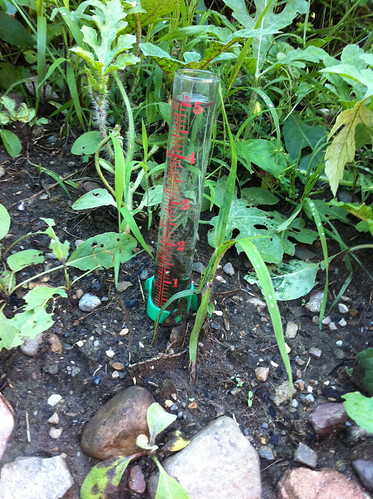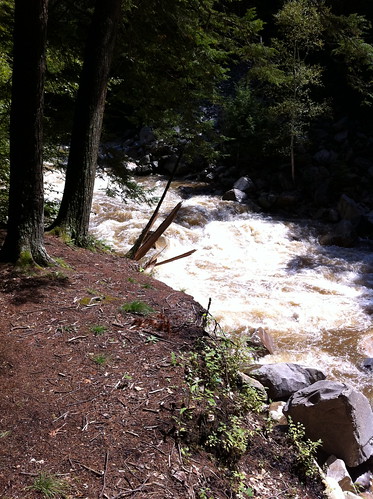
After Hurricane Irene passed through East Middlebury, my rain gage was nearly full. Unfortunately, I hadn't been a dutiful weather reporter. Because I was out of town for a couple of days before the storm (and braved the outer rain bands to race the storm north from the Berkshires the night it was rolling into town), this rain may have included a couple of thunderstorms before the main storm. On the other hand, the gage was obviously tilted, and was so full that water was probably splashing out almost as much as fell in by the time it was that full. So, I know we got a LOT of rain, but I'm not sure quite how much.
I'm sure others out there have better data. If you do, sharing this data could result in better flood forecasts and improved understanding and management of Vermont's rivers. George Springston, geologist at Norwich University in Northfield Vermont, is looking for data on Irene's precipitation. In particular, data from anyone living in the mountains would be very valuable as these areas were drenched in torrential rain by Irene and are also sparsely populated.
If you think you can help, I'd love to hear from you. Leave a comment on this post with as much of the following information as possible: location of your rain gage (this one is essential!), type and diameter of rain gage, precipitation totals for the storm and any taken partway through the storm if available, and any other comments or observations. I'll make sure the information is passed on to George Springston.


It's been cold and wet here in Sweden as well. In fact the trees are still mostly dormant which is causing everyone to take notice and make comment. Winter's cold is hanging on.
ReplyDeleteWe were in Poland last week and their trees are finally starting to bloom. Temps were around 25C or 70+ F.
I can see in the lower photo showing a stream with spring run off which naturally has the characteristic brown colouration, but then it usually clears up by late spring. At least when I lived all those years in the San Jacinto mountains they did. But over here in Sweden, I have never seen their streams or rivers clear up ever. They are either black or dark brown looking. Folks here tell me you have to go up into the mountains bordering Norway to see clear rushing streams.
Some have said it has to do with the large massive amounts of peat in the landscape, but I don't necessarily buy that either. They practice a horrible industrial type of forestry here. I hate it. I plan to take photos and do an article later this summer here. The usual propaganda story is that Sweden is Eco-Green, but that is not exactly true. I do have some pristine small woods around me and there are some small brooks and streams that run off and have a definite crystal clear character to them. It's only when they merge with the larger water sources downstream that they cloud up.
One of the P.R. campaign poster child stories the Forestry tells here is that they don't take all the trees, they leave some for wildlife. This is a joke, as the trees they leave are spindly pathetic unusuable leftovers that the foresters didn't want anyway and they are few and far in between. These forests here DO NOT have a whole lot of wildlife anyways and that may surprize many over there. Including birds and squirrels. We are talking 10s of 1000s of hectares of forests that are so densely packed that no other plant life lives under or around them, with the exception of some fringes. These other plants are the true food sources for wildlife and they are nonexistant.
When we flew over Poland last week I noticed the same industrial pattern with rows of dense trees by the millions and logging operations everywhere. You could also see every lake and pond with huge algal blooms. Germany also has the same issues.
I've got to spend some more time reading your articles, thanks - Kevin
Thanks for your post!
ReplyDeleteHave you had a cold winter? Ours has been incredibly warm and snowless,which I didn't particularly like. Unfortunately the warm weather caused the trees to all leaf out especially orchards and vineyards... And we are expecting near record cold tonight and tomorrow night. This very hard freeze is bad news for the orchards and vineyards , and my even harm some of the native plants as they have also leafed out early. As I speak it is already snowing in the mountains, though no snow is expected here. It has been a very odd winter and spring.
The river in the photo, the Middlebury River, is one of the cleanest in Vermont. It is muddy after floods, and especially after Irene, but it clears out fast to beautiful clear water. During lesser rain storms the river often becomes the color of tea due to tannins (I think) leaching out of all the dead leaves in the watershed. We have a bit of peat in the watershed too, not much. It is very easy to tell the difference between this and mud which looks more like chocolate milk. Our state's management of the river and watershed is not perfect, as
Mentioned sometimes in this blog, but in general Vermont does a very good job. (sorry for the multiple posts) there is some sort of bug when posting using an iPad).
DeleteAs for forestry, it is not enough to leave a few trees in a cut over area. It is also necessary to leave at least a little bit of each ecosystem unlogged indefinitely. This keeps the genetic and species diversity high and able to adapt to changes
In the ecosystem over time, such as those caused by climate change or introduction of invasive tree diseases. Also, it sounds like your area experiences replanting which as discussed in our previous posts is not always great. Even if appropriate species are planted, genetic diversity and local adaptation is lost unless seeds are collected from an area before logging which is rarely if ever cost effective. Planted trees from a nursery just don't provide the same ecosystem and watershed benefits. As for planting in rows I don't know if it has effects on ecosystem function but it certainly looks silly.
DeleteAnyway, I am getting off topic here but thanks for reading and for the post!
Actually Charlie, the weird thing is that the winter here was way milder than the last two years. So the delay in leaf and flower bud breaking is odd and even common everyday folks are talking about this. There are always certain species that bud out later than other, like their native oak tree. But some trees are now starting to bloom since i last posted.
DeleteWhen I talk about murky water I'm talking about streams, creeks and rivers here than never ever once clear up. Of course there are times when it seems like the wet never stops falling from the skies here and I'm not from an area that traditionally receives constant rain anyway.
When it comes to forest management, everything is monoculture replant. Most all replants are always Scots Pine (Pinus sylvestrii). There is alot of evidence that at one time southern Sweden especially was more Oak forested, but wooden ship building took care of that. We have an area in Göteborg called Masthugget which means Mast Hewn. All the oak tree were cut down for ship building.
For the moment I've got to run, but I'll be back.
Kevin
you could put some water from a creek in a glass container and leave it sit for a few days. Silt and even clay will eventually settle out, but tannic acid wouldn't.
ReplyDeleteIt's too bad no one is replanting your oaks...
"It's too bad no one is replanting your oaks..."
DeleteYeah, no kidding. I'm about ready to post some articles on the Euro side of things and their so-called bogus Eco-Green chest pounding. I've been taking several pics in the woods and I'd like everyone to see just how their version of industrial forestry doesn't work any more than US or Canadian methods.
There is an environmental radical activist here who does documentaries on various global non-eco ways of doing things. The guy pumps up Sweden and criticizes other countries. The last one he did was from a location in Siberia where pristine old growth is being cut and milled for IKEA furniture. Yet, he never mentions the fact that Sweden basically like all EU countries has raped their old growth forests and has done NOTHING whatsoever to change policies to allow old growth to return. I saw these same methods being done in Poland a couple of weeks ago when I was there.
Anyway, stories from the Svenskland are going to get more interesting on my blog. Presently we have what looks to be the makings of a future old growth or as close to it as possible outside my neighbourhood with some of the largest trees like Birch & Scots Pine and proper migration of newer tree forms like the oak and maple which here actually need those nurse trees and the plans this summer to cut the whole forest down and build those generic Soviet Style Socialist highrise housing projects in their place.
(they have no class here in creative style, imaginative artistic ability or character when it comes to architecture here in Scandinavia)
You can't imagine how discusting this will be. But I'm documenting every step. The rush is to capture on film what will be erased in a matter of a couple of weeks.
Thanks for your articles - Kevin